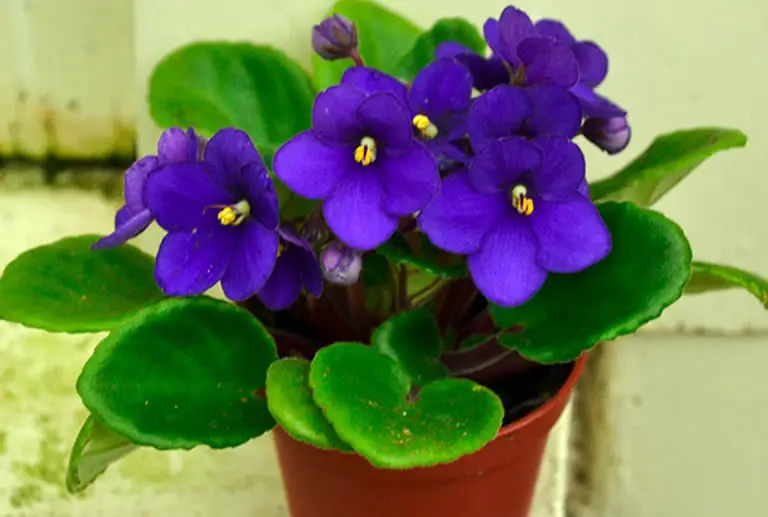African Violets are adored for their interestingly textured foliage and bright blossoms. But, this plant species can be intimidating for many outdoor gardeners and indoor potted plant enthusiasts since they need specific care routines and specific environmental conditions for optimum health. And it all starts with leaf care.
Table of Contents
- African Violet Leaf Problems & Their Fixes
- How to know if your African Violet is short on leaves
- Why your African Violet leaves are turning light green & what to do about it
- Why your African Violet leaves are turning pink & what to do about it
- Why your African Violet leaves are turning black & what do about it
- Why your African Violet leaves are turning yellow & what to do about it
- Why your African Violet leaves are turning orange & what to do about it
- Why your African Violet leaves are turning brown & what to do about it
- Why your African Violet leaves are turning white or pale & what to do about it
- Why your African Violet leaves are fuzzy & what to do about it
- The main causes that make African Violet leaves curl & how to deal with them
- Why the bottom leaves of your African Violet are dying & what to do about it
African Violet Leaf Problems & Their Fixes
There are hundreds of African Violet varieties and even hybrids, ranging from miniature violets to trailing variants.
With so many possibilities concerning colors and foliage, identifying potential problems can become quite challenging for many people.
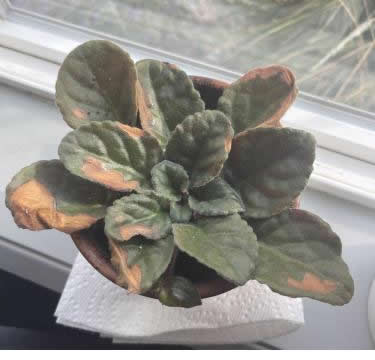 So, join us here as we discuss African Violet’s characteristics, especially as that relates to leaf problems.
So, join us here as we discuss African Violet’s characteristics, especially as that relates to leaf problems.
I show you how to spot problems and, more importantly, how to resolve them to ensure the plant’s optimal health over time.
How to know if your African Violet is short on leaves
Many owners of african violets, especially potted houseplants, worry if their plant is showing signs of problems do to a lack of leaves.
How many leaves should an african violet have?
The majority of African Violet trailing varieties should have 3 or 4 rows of leaves, which equates to approximately one dozen leaves.
Larger African Violet varieties typically boast larger leaves without necessarily increasing the total number of leaves.
The approximate number of leaves on an african violet will be dependent on the variety but there should be several rows each with several leaves on it.
A leaf growing on a new layer will be positioned to sit above but in between two leaves on the lower layer.
This layering effect should gives the appearance of abundant foliage without there necessarily being a lot of leaves on the plant.
Trimming African Violet leaves is important for stimulating new growth
Should you trim the leaves of my plant? This is a question I hear often from lovers of all types of of succulents not just african violets.
So what should you do?
Unlike the foliage of some succulents, such as amaryllis leaves which should never be trimmed, without trimming the leaves on an african violet can lead to aesthetic problems.
Failure to trim the leaves means it can become challenging for african violet to produce fresh and healthy leaves without overcrowding its area.
Overcrowding can make it difficult for bloom stalks to traverse to the top thus reducing the number of flowers the plant produces and it can also lead to deformed or misshapen foliage.
Trimming is therefore very advantageous for the plant especially with varieties that flaunt ruffled or wavy leaves and you really need to trim these african violets regularly.
Be careful that you do not leave bald spots in the foliage when you trim the leaves. Your aim tis to remove access foliage only.
You can follow the plant’s symmetry and form for trimming.
Trim from the bottom up, remove leaves that are not visible from above, and remove leaves that grow from axils between existing leaves.
The color African Violet leaves should be
Another concern for many people is the color of the foliage of the african violet.
What shade and color should african violet leaves be?
The leaves of african violets should be a rich, bright green color, not too light but not very dark either.
Generally, their leaves should remain a healthy shade of bright deep green within the appropriate lighting conditions.
Although some varieties have instabilities concerning leaf colors anything but bright green may be an indication of problems with the plant.
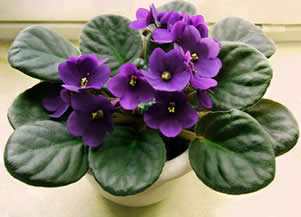
If your African Violet leaves are a very dark green, it is likely due to the plant not receiving enough sunlight.
This scenario is commonly coupled with weak petioles and stems, and foliage that appears thinner than usual.
South or west-facing windows are best for providing indirect natural light during cool seasons, while east or north-facing windows are best during warmer seasons.
Please don’t touch African Violet leaves
Can you touch African Violet leaves?
It may be tempting to touch this plant’s alluringly textured foliage, but African Violets do not like to be touched – at all. So don’t do it!
Touching the leaves of an african violet can cause damage, stunted growth, and other adverse effects.
One affectionate stroke or handling the foliage as part of a treatment program is unlikely to cause severe harm.
But just to be sure your plant remains healthy it’s best to limit physical interaction with the foliage to only those times that involve necessary care.
Why your African Violet leaves are turning light green & what to do about it
There are various problems that can occur with the shading and color of african violet leaves and I will cover the most common ones here.
Arguably the most common one is a lightening of the shade of the leaves.
African Violet foliage will turn pale or light green when the plant is exposed to too much sunlight.
Often this shading problem is coupled with bleached or burnt leaves. African violet does not like too much direct sunlight.
Light green leaves are often seen on plants that are placed on sun facing window sills.
Such areas may be providing too much direct sunlight during the summer months, something which is not favorable to this plant.
If you notice that your african violet leaves are being to fade in color then your first course of action is to move the plant to a more shaded area.
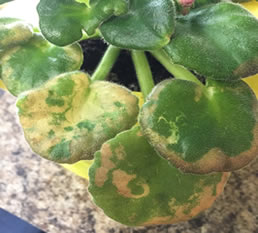
Alternatively you can cover windows with sheer curtains to reduce the amount of direct sunlight reaching the plant to alleviate the risks of leaf burn and loss of foliage color.
Some tests may need to be done in your home to find the best spot for this plant as african violet need plenty of light but react poorly to too much direct sunlight.
Some gardeners actually prefer to use artificial light sources when cultivating and growing young african violets as they can strictly regulate the amount of UV rays reaching the plant.
It is unlikely you will want to go to such extremes os using artificial lighting conditions as this is a practice followed mostly by people who grow the plant’s to sell.
However, it does indicate just how sensitive this plant is to excessive and insufficient sunlight.
So, just use a trial-and-error method of moving your plant to different locations until you find the sweet spot that offers the plant plenty of light but not too much direct sunlight.
How do you do that?
So how much sunlight does an african violet need?
So exactly how much light does an african violet need?
African violet requires approximately 14 hours of light and 10 hours of darkness each day.
If your african violet does not get a minimum of 8 hours of darkness each day it will not bloom and the leaves will likely start to fade in color and look light green.
As african violet require darkness in order to produce flowers.
The plant does not respond well to sustained direct sunlight, this may mean you need to move the plant to a more shaded area especially in the summer months.
Why your African Violet leaves are turning pink & what to do about it
It can be dismaying to see pink leaves on your african violet. What causes this?
In most cases where healthy african violets have pink leaves it is usually linked to genetic instabilities in the plant.
One example is the Saintpaulia Hovariagata, a small and bushy African Violet variety, that produces pink leaves a few times a year.
In less common cases pink leaves can be caused by incorrect temperatures, watering and humidity levels.
It is very common to see pink leaves on african violet. This is nothing to be concerned about.
Saintpaulia Hovariagata is a perfect example of an african violet plant that will display pink leaves, usually more than once every year.
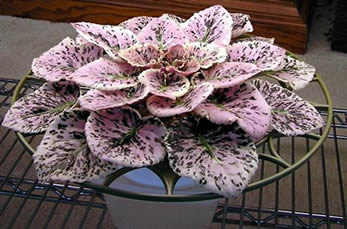
Some african violets will have leaves that turn varying colors.
Again, this is nothing to be concerned about as long as the leaf color does not last longer than a few weeks and as long as the plant is not showing other signs of distress.
You will know that there is nothing to worry about, and that this is a natural cycle for your plant, if the pink leaves only last a few weeks each time they show.
After a few weeks the pink leaves will once again regain their natural green color.
However, pink leaves may also indicate fluctuations in temperature, humidity, and water supply.
You will need to do some testing over a few weeks to identify the cause and amend care routines as needed for the plant species.
Why your African Violet leaves are turning black & what do about it
Black african violet leaves can be incredibly distressing to witness. Sadly, this condition can be extremely dangerous for your plant’s longevity.
The plant requires immediate attention.
In most cases, black foliage is caused by sooty mold, which can be due to insects and pests, including whiteflies, mealy bugs, and aphids. These are infamous enemies of many different varieties of both indoor and outdoor plant species.
To treat such cases, the african violet will need to be inspected for any intruders that may be causing the sooty mold.
Be sure to not excessively touch the leaves during this inspection.
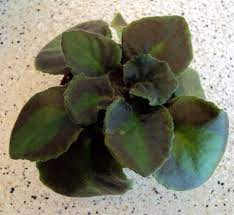
There are some very good quality pest control products available on the market, like theses ones.
You can use any product that is suitable for removing pests from an african violet and you should use one without delay once you see pests.
After applying insecticides to the plant the african violet will need very attentive care to regain its former health.
Repotting, once the plant has started showing signs of recovery, in a new pot with new soil is a good idea.
Don’t repot immediately as this may cause just enough stress to the plant to kill it if it is in very bad shape – wait until it starts to recover.
Why your African Violet leaves are turning yellow & what to do about it
There are a few potential reasons why the leaves on an african violet start to turn yellow.
The most common cause for african violet leaves turning yellow is improper watering.
However, lack of nutrients in the soil, and other soil-related issues can also lead to a yellowing of the leaves.
Incorrect soil and excessive salt may cause african violet leaves to produce a yellow shade.
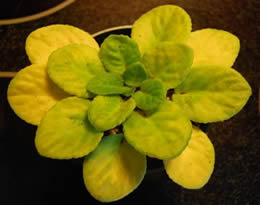
To get to the exact cause of a yellowing of the leaves on your african violet you will need to try a few approaches to identify the cause and resolve the issue accordingly as outlined below.
Improper watering can cause a yellowing of African Violet leaves
An inappropriate watering routine is the most common reason for yellowing foliage on african violets.
African violets require a specific watering routine.
African violets do not appreciate water getting directly onto their leaves.
You should therefore never water the leaves of african violet and instead pour the water onto the soil underneath the lower row of foliage.
Applying water directly to the foliage of an african violet will lead to a yellowing effect of the leaves.
It can also cause necrotic spots, ring spots, or a bleached appearance.
Room temperature water should always be provided to the plant, as water that is warmer or colder than room temperature can cause damage to the cell structure of the foliage.
Sadly, there is no cure for yellow leaves except removal.
Yellow leaves will need to be trimmed off.
Still it’s not all bad.
Trimming these damaged leaves will allow the plant to focus on growing fresh new healthy foliage.
From that point forward you should always ensure you follow proper watering practices for future care routines.
Using an inexpensive self-watering african violet pot is a great way to ensure your african violet receives the exact amount of water it requires.
Insufficient nutrients in the soil can lead to yellow African Violet leaves
African violets may have yellow leaves to indicate that they are malnourished, as they will not have enough resources to produce the normal bright green foliage.
African violets are feeders and they need to be fertilized once a month in the growing season for optimum health.
Any fertilizer with an 8-14-9 mix will give an african violet all the nutrients it needs to thrive.
I have found that this brand concentrated liquid fertilizer, and also this organic liquid fertilizer, maintain the best foliage and help produce abundant bright healthy blooms.
Other soil issues can lead to yellowing in African Violet leaves
African violet does not appreciate standard soil mix. If you are growing african violet in potting mix that is appropriate for other succulents, such as amaryllis, the plant will not grow well.
African violet requires well drained specific type of potting soil that does not actually contain regular soil/dirt.
In a push you can use regular potting mix but if you want a really healthy plant with stunning blooms then you are best using soil that is a mixture of sphagnum peat moss with vermiculite and perlite.
This stuff works great with all varieties of african violet.
Even if you have the correct soil there can still be problems with the particular mix you have used.
For example, if the soil your african violet is growing in houses excess salts and waste, it can lead to a yellowing of the leaves.
In such a case the soil will need to be drenched four times annually to wash away the excess salt.
You must ensure the soil provides sufficient drainage as african violets will react poorly to saturated soil.
African violets need to be repotted twice per year, since the soil that plant grows in gradually loses nutrient content.
Also, even though you will be feeding the plant regularly during growing season the texture of the soil changes over time making it difficult for the plant to absorb nourishment and water.
Why your African Violet leaves are turning orange & what to do about it
African Violet foliage will commonly turn orange when the plant is given too much fertilizer.
While the african violet is a feeder and requires more frequent fertilization than many other common plant species and succulents, too much fertilizer will cause it to experience various problems.
You should only provide fertilizer as needed and should ensure the soil is drenched with water occasionally to wash away any excessive fertilizer it contains.
This is another reason to have good-draining soil and a pot with sufficient drainage holes.
As I already mentioned, many owners of indoor african violets use inexpensive self-watering african violet pots. These pots work really well to ensure the plant receives the exact amount of water it requires.
Why your African Violet leaves are turning brown & what to do about it
Although less common than yellowing leaves african violet foliage can also turn brown.
In most cases, the leaves of African Violets will turn brown when exposed to very strong direct sunlight or when they are given too much prolonged exposure to sunlight.
This may be coupled with curled leaves that appear scorched.
The plant should be relocated to a shaded area that only provides indirect sunlight and that offers at least 8 hours of darkness per day.
African violet leaves can turn brown, as well as yellow, when they are exposed to too much direct sunlight.
You should initially move the plant to a more shaded area that has plenty of light but much less direct sunlight, or no direct sunlight at all – at least until the plant starts to recover.
Be sure that you are not confusing a browning of the leaves with a blackening of the leaves.
Brown leaves are easy to deal with by simply relocating the plant but black leaves are most likely an indication of disease or pest infestation (see section, Why are my African Violet leaves turning black?, above).
Why your African Violet leaves are turning white or pale & what to do about it
Although much less common that the other changes in color previously mentioned, african violet leaves can also turn white.
This white appearance is also referred to as leaf paling due to the leaves taking on a pale pigmentation.
The foliage of african violets will turn white with the presence of powdery mildew.
This can easily occur when there are inconsistent temperatures in the environment.
Various tests will need to be done to find a suitable area with stable temperatures.
Though, you can apply Neem Oil and fungicide to assist the plant in its healing process.
When an african violet shows signs of leaf mildew growth it is growing in an areas with temperatures that vary too much.
African violets will grow best in temperatures of around 70° – 80°F during the day, and around 65° – 70°F at night.
Large variations from these temperatures over a prolonged period can lead to mildew growth and you should treat the plant with either neem oil or a good quality organic fungicide like this one from Dr. Earth.
Why your African Violet leaves are fuzzy & what to do about it
Although the African Violet is infamous for having “hairy” foliage, it should not be fuzzy.
Fuzzy leaves on an african violet are typically caused by a Botrytis infection, commonly coupled with a gray-toned appearance on the foliage.
This is usually caused by high humidity levels.
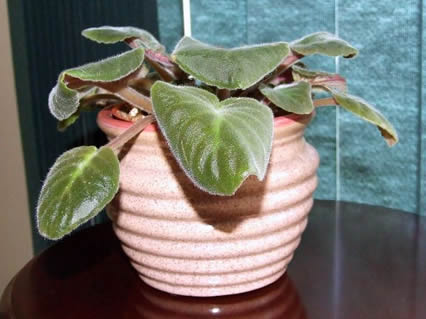
To treat your african violet for Botrytis infection cases, you need to quarantine the infected plant immediately, as the infection can spread to neighboring plants quite easily and very quickly.
Any foliage that appears to be infected or ill will need to be trimmed off immediately to stop further infection of unaffected leaves and new leaves.
Fungicide will need to be applied to help the plant rid itself of the infection so it can regain its health.
The same organic fungicide I mentioned above works well to eliminate this problem.
After treatment, when the plant begins to show signs of recovery, it should be repotted in a new pot with fresh soil.
Although some people will clean the old pot and reuse it I never take the chance.
I clean the pot (so it doesn’t have the opportunity to cause unforeseen problems) and then dispose of it.
The main causes that make African Violet leaves curl & how to deal with them
There are a few reasons why an african violet may have curled leaves, and caregivers will need to try a few approaches and inspect the plant to find the cause.
Cold temperatures can cause African Violet leaves to curl
When african violet is kept in an environment that is too cold for it over extended time periods the leaves can become brittle and begin to curl under.
These instances are often coupled with excessively furry foliage, inhibited growth, and center foliage that is tightly bundled together.
Similarly, the leaves of the plant may display these symptoms if they are watered with very cold water.
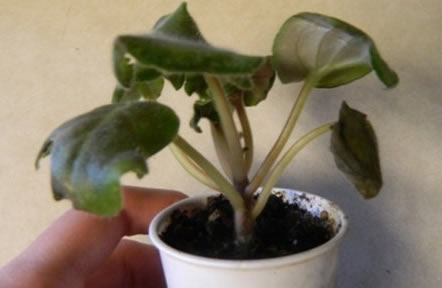
You should always ensure that African Violets grow in temperatures around 60° – 80°F during the day and 65° – 70°F at night.
It is important to provide african violet with compensating warmth indoors if temperatures are drastically cooler during lowlight hours.
Remember this is a tropical plant and it does not like the cold, even when protected from extreme outdoor temperatures.
Mite infestations can cause African Violet leaves to curl
Mite infestations can also cause curled leaves but will be coupled by additional symptoms.
Signs of a mite infestation include damaged leaves, especially within the center foliage, and problems with blooming or a total lack of blooming.
Sadly, there are no promises of recovery when it comes to mite infestations.
While you can try using miticide and insecticidal soaps, some owners rather opt to dispose of the plant and disinfect anything that it has come into contact with.
If you do want to try to save the plant then be sure to isolate it in an area away from other plants.
Use a proven mite spray and although you should not usually water the foliage of african violet you will need to spray it with mite control liquid as well as treating the soil.
If the plant does recover you will need to repot it.
Why the bottom leaves of your African Violet are dying & what to do about it
The most common cause for dying leaves at the bottom of African Violets is insufficient water or too much water.
Insufficient water causes shriveled roots and leaves that will fall off the plant.
Overwatering causes limp leaves, leaf loss, and crown and stem rotting.
You will need to trim off the bottom leaves that are dead and then follow the appropriate watering techniques in the future.
While African Violets are undoubtedly require more attention and more specific care than many other plant species, their beauty and unique traits are worth the effort.
This shy, delicate, and elegant plant has made many plant-lovers exceptionally happy and has brought bright color spectrums into countless homes.

